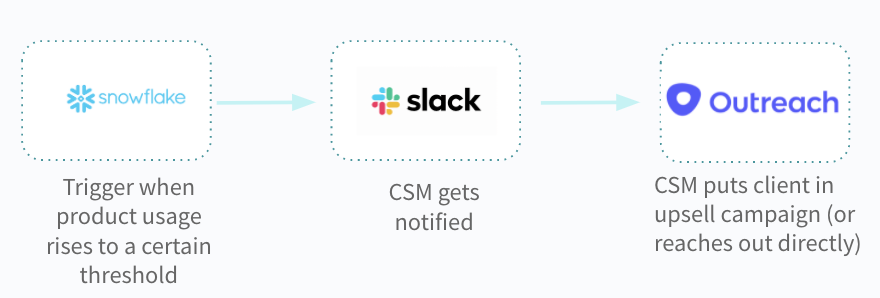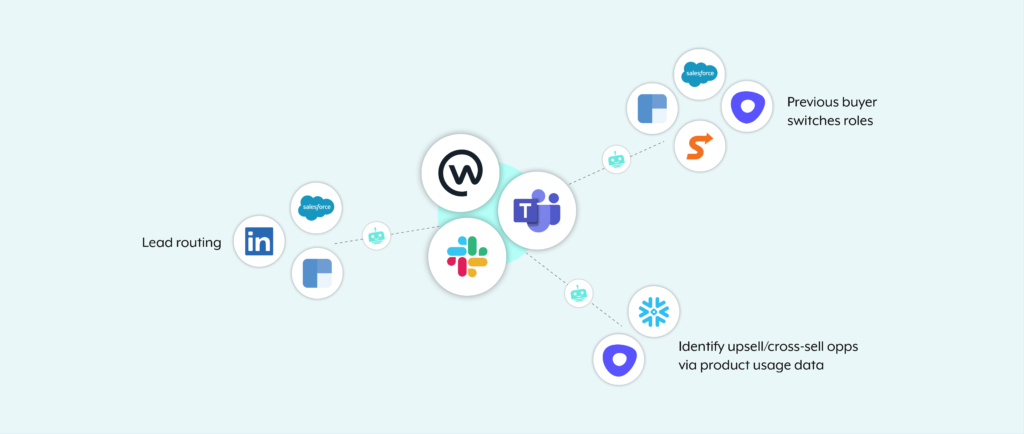Your leads can come from a variety of places, from a demo request form to an email nurture sequence.
No matter their source, you can manage each effectively by using marketing automation. Why? Because marketing automation allows your customer-facing teams to uncover hot leads in real time, access invaluable insights on each, and take action—all without leaving your organization’s business communications platform (e.g. Slack).
We’ll review how, exactly, marketing automation can support your lead generation and nurture efforts by walking you through 3 examples.
Related: The ultimate guide to implementing marketing automation
1. Route leads intelligently and through the platform your reps already use
To have any chance at converting an inbound lead, you’ll need to respond to them in minutes. Research by the Harvard Business Review proves why: Delaying your organization’s response time from 5 to 10 minutes lowers your odds of qualifying a lead by 400%.
So how can you enable your reps to contact inbound leads within 5 minutes? By routing leads intelligently.
Here’s how your lead routing workflow can work:
Once a new lead comes in, an enterprise chatbot can message the appropriate rep in a platform like Slack and notify them of the lead. The message can include the note the lead left when they submitted the demo request (if applicable), their details in your CRM (if it exists), insights from an enrichment tool like Clearbit, etc. The rep can then decide whether to accept, reject, or reassign the lead with the click of a button.
Related: 4 tactics for improving your speed to lead
2. Identify previous buyers who switch jobs and nurture them immediately
When someone moves to a new company, they’re likely looking for ways to make an early impression. And when that someone is a formerly happy client of yours? They might want to bring your product along with them.
Here’s a marketing automation that can help your team identify and nurture this type of lead successfully:
1. Once a former user changes jobs (which a data enrichment platform uncovers), and their details in a CRM, like Salesforce, are edited to reflect this, the workflow gets triggered.
2. An enterprise chatbot messages a specific channel in a platform like Slack, notifying members of the job change and the details around it.
3. A member of the channel can put the lead into the appropriate nurture campaign in a platform like Outreach with the click of a button.
3. Use product usage data to put clients into upsell/cross-sell campaigns
Your clients also present your organization with new revenue opportunities.
You can identify and nurture clients who are ready to move on to a more advanced version of your product (upsell) or are interested in an additional product you offer (cross-sell) by implementing automations based on product usage.
For example:
1. Once a client’s level of product usage (as measured in a platform like Snowflake) exceeds a certain threshold, the workflow gets triggered.
2. An enterprise chatbot notifies the employee who manages the account (via a platform like Slack) of the client’s product-usage level and that they’re a good candidate for the next product tier.
3. The customer-facing employee can, with the click of a button, put them into a relevant nurture sequence using a platform like Outreach, or, if they’d prefer, respond to the client directly.

Related: A guide on lead automation
Ready to automate your lead management processes?
You can use Workato, the leader in integration-led automation, to automate any marketing workflow without compromising security and governance. You can also use Workbot, our very own enterprise chatbot, to fuel each workflow and to ensure that your team doesn’t have to leave your business communications platform when performing a task.
To learn more about Workbot and the Workato platform more generally, you can schedule a demo with one of our automation experts!
